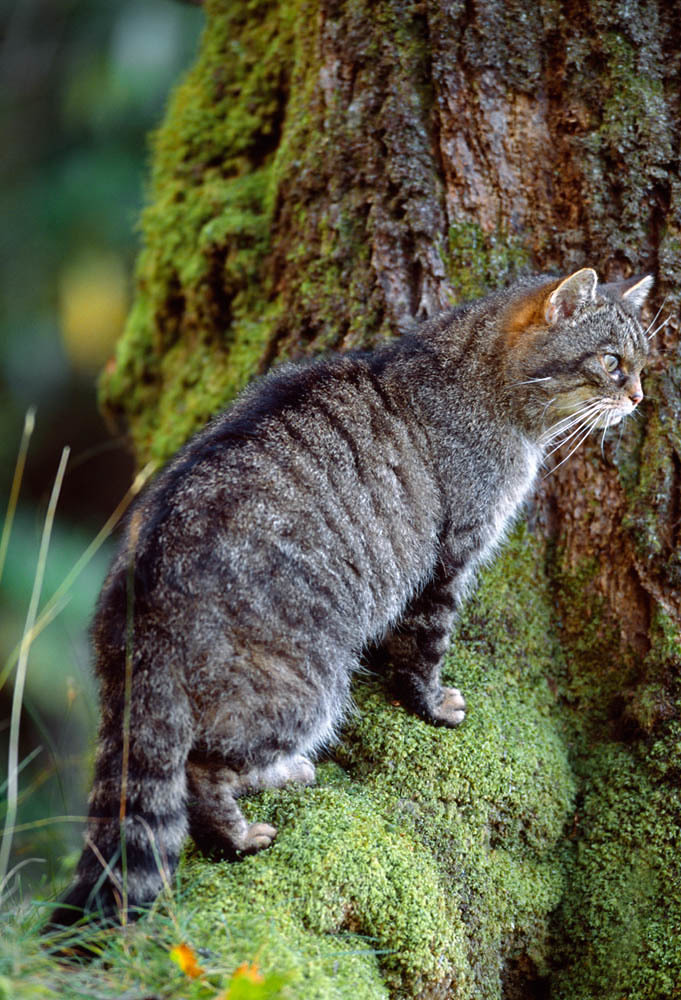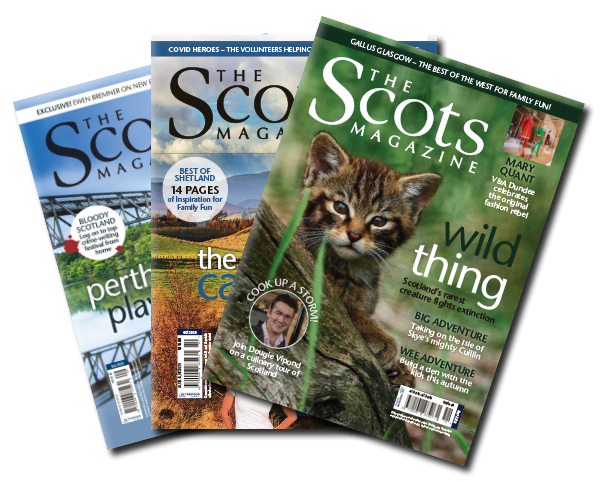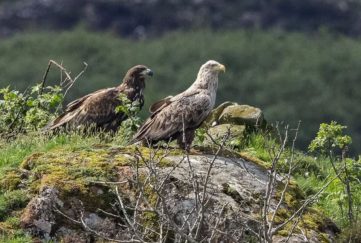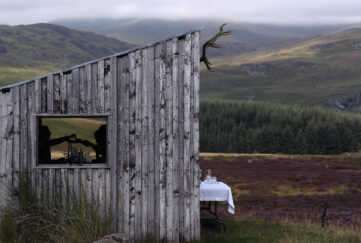Wildcat Versus Lynx

Save one from extinction or reintroduce the other? Jim Crumley asks which is easier
Finally, I saw something lying at the foot of a tree, inert as gravestones, but I had to have it pointed out to me even though I was looking for it.
Then I realised there were two somethings, but they were hardly what I expected to see, for they had collapsed their characteristic shapeliness into the contours of the wood’s understorey, and into which they had blended supremely, like two old logs that had lain undisturbed for long enough to lose all their bark and to bleach in the sun.
Finally, I made out a pale flank that rose and fell rhythmically but minutely, the shallowest of breathing.
My voice must have betrayed my disappointment:
“That’s a lynx?”
My guide was the manager of a small wildlife park whom I was interviewing for a radio programme about Scotland’s extinct mammals.
“Yes,” he said, “and most people most of the time will see a lot less of them than that.”
“Less than that?”
“Yes. In the wild they’re deep forest, they’re mostly nocturnal, and they’re the quiet side of secretive. But they’ll kill a roe deer.”
“A calf though, right?”
“Yes, a calf, or a doe, or the biggest buck you ever saw.”
I looked back at the foot of the tree. Nothing stirred. I imagined the headlines: Roebuck killed by log.
An Irritation of Magpies
And then two magpies flew over.
Magpies don’t like cats and tend to make quite a fuss when they’re around, usually from a safe distance. These two had seen two cats. What they failed to take into consideration was what constitutes a safe distance when the cats happen to be lynxes.
They perched in the top of the tree, perhaps 20 feet above the comatose animals down by the roots. They cranked up the volume. Two magpies in full voice amounted to a significant breach of the late-morning’s cat-napping peace. I imagined a single eye opening speculatively. Think Tom in Tom and Jerry.
Two magpies are also blatantly eye-catching in midday sunshine, and if you are a drowsing cat, probably irritatingly eye-catching. They began to flutter and hop down through the branches, clatter-chattering their loud and charmless paradiddle as they descended. The lower one was still about ten feet above the unmoved and unmoving cats, and if it occurred to the magpie at all that this was slightly unusual cat behaviour and that it called for a strategy rethink, it occurred too late.
One moment there was a shapeless old log sprawled among the roots. The next there was a vertical missile in mid-air that unleashed the curving swipe of a fully armed paw aimed at the magpie. The bird screeched and rose in a pied slaister of feathers, the claws missed their target by, I would guess, half an inch. The thin branch where the magpie had been snapped like a cocktail stick. Then the cat was back on the ground, sitting up, blinking in the sunlight, and watching – wistfully it seemed – a small cloud of feathers that drifted down the still air.
“Ah, that’s a lynx,” I said.
The tree was bare of magpies
I have played that sequence of events over and over in my mind countless times, and (this being the age of high-definition television replays in super slo-mo) how I would love to see it broken down frame by frame so that I might understand better how the thing was achieved.
The whole episode from horizontal and apparently dozing to vertical and several feet off the ground to attempted murder of a magpie to sitting meekly back on the ground watching the drift of feathers could have lasted no more than three or four seconds. And of course I only saw it once and in real time and at a distance of about 50 yards.
That was the first time I had seen a lynx, and it remains the only time, but it engendered in me the healthiest respect for the species, not to mention an aesthetic appreciation of its undeniable beauty.
An Endless Debate
And people keep asking me about the lynx. It seems to be at the top of every other nature enthusiast’s list for reintroduction into Scotland. I have been talking for quite a long time now about reintroducing wolves.
My recent sequence of four books – The Winter Whale, The Last Wolf, The Great Wood, and The Eagle’s Way – have all mentioned the wolf to some extent or other.
I have found, too that talking about them at book festivals and other events, the topic of wolf reintroduction arises again and again.

Should we reintroduce the lynx?
And then someone is bound to ask:
“What about the lynx?”
And some of them will add:
“Would that not be easier?”
The short answer to the second part of that question is yes. But only because nothing in all nature conservation at least in a Scottish context is more difficult than winning a hearing for the wolf, this despite the fact that there is simply no other more effective single gesture that we could make on behalf of all nature than putting back the wolf.
Scotland’s Wild Cats
But there is no short answer to the first part of the lynx question. And so, here is my long answer. I am hesitant about lynx reintroduction in Scotland because I do not know how it might affect the Scottish wildcat, and I do not think many other people know either.
The wildcat is staring extinction in the face, so much so that estimates of its surviving population vary between about 30 and 300, which is a very reliable indication that no-one knows. If it’s 30, then that is as near to extinction as makes almost no difference.
There are captive breeding programmes out there, although the numbers involved are very small. And there is at least one feral cat neutering programme to try and stop interbreeding with true wildcats. Interbreeding dilutes the hereditary bloodline and in some cases creates hybrids with different behaviour patterns from true wildcats. But I do wonder about the obsession with 100 per cent pure Scottish wildcats. If we applied that yardstick to the race of people we call Scots, there would be no-one left, for we have been hybridising forever.
So I incline towards the notion that it does not make good conservation sense to add to the woes of the wildcat by introducing another big cat into the Highlands, while at the same time conducting a desperate rearguard action to save the one cat species that we still have.

Scottish Wildcat (Felis silvestris grampia) semi habituated female in summer coat, living wild in native oakwood
The Cat of Nine Lives
The wild cat has been in trouble before and recovered. One of the best of all our naturalists (and a seriously underrated writer) was David Stephen. In his book The World Outside , published only 30 years ago, he wrote:
“Keepers and shepherds have always tended to wage war against the cats of the hill, perhaps as much for what they might do as for what they did. At one time, 50 years ago, the wildcat almost went the way of the polecat. Now it is as plentiful as it has ever been in recorded history.”
So while you ponder that fact and its implications as to how the wildcat can be so threatened once again and after such a recent time of plenty, while you ponder how the war-waging can still prevail despite all the legal protection our country has ever devised for wild animals, how’s this for a word portrait, as drawn by David Stephen:
“Behold the Scottish tiger – Felis Sylvestris Grampia! See him padding high across a wild scree in the slanting morning light, big-fisted, wide-eared, long of limb and tusk, with ringed club-tail, and you’ve seen one of the lords of life: a cateran of fire and brimstone, implacably savage, reputedly untameable…
“the devil’s black laughter”
“You’ll hear the treason whispered that there’s no such animal. For shame. English red squirrels we have; even English ways. And Swedish capercaillies, Japanese deer. And Norman, ex-Spanish rabbits. Our grey squirrel is an American. But the wildcat is our own – and real. Hark to the wild pibroch of him, as he stalks through the gloom of the corrie when the moon is riding high. This is the devil’s black laughter: hiss and crackle, scream and sob. The wildcat’s skelloch is of the lonely places, of mountain and high forest. Beside him the caterwauling alley cat is a cartoon clown.”
I haven’t met a wildcat out in the wild for about ten years now. I did meet two within the space of a few months, however – one in a quiet backwater of Glen Dochart in broad daylight, the other in the dark at Balquhidder.
The Glen Dochart one was a blur on a single-track back road as I cycled towards Killin. There were pieces of rabbit on the road and a splash of blood. I watched cat and rabbit corpse thread a path uphill through bracken and rocks. A hundred yards up the hill the cat stopped, dropped the rabbit, turned to stare back down at me, looked around in every direction, resettled the rabbit into its jaws and disappeared into the hillside. I waited and waited, and eventually saw it again much higher and much further west, and as far as I could see the rabbit was missing.
The sob of a wild cat
At Balquhidder, I was out for a late evening walk down to the River Balvaig on a night of deep winter and a million stars. I had been walking for about ten minutes when I heard the eeriest sound of the Highland night, not the hiss or the crackle or scream of a wildcat, but what David Stephen called the sob.
“Mau,” it said, and the voice was deep and throaty and velvety. I shivered inside my warmest jacket. Then from much further to my right, a second voice:
“Mau.”
I simply stood dead still. If they had my scent, and quite possibly the sight of me too (for their night eyes are as good as yours and mine in sunlight), the best I could do was not give them sound or movement to work with.
There were two more monosyllabic exchanges, then silence. I stood until I was too cold for my own comfort, and decided I could do no more. But I was back there in the early morning and I found the remains of either two or three pheasants. I could not say which with any confidence.
The Scottish wildcat is a phenomenon. We should be investing serious resources on its future wellbeing, but we are nowhere near doing that. Instead, we are talking up the lynx because re-introducing the lynx (from Norway or Sweden to go with our Norwegian sea eagles, our Norwegian and Bavarian beavers, our Spanish and French red kites…) with neck collars and transmitters and all the other plastic accoutrements of 21st century professional conservation is much, much easier than trying to stem the tide of extinction that threatens yet again to drown the wildcat and silence for good the devil’s black laughter on Highland hillsides.
You can read more of Jim Crumley’s Scottish wildlife columns online here, and each month in The Scots Magazine.
Subscribe to The Scots Magazine today for more from Jim Crumley >>






